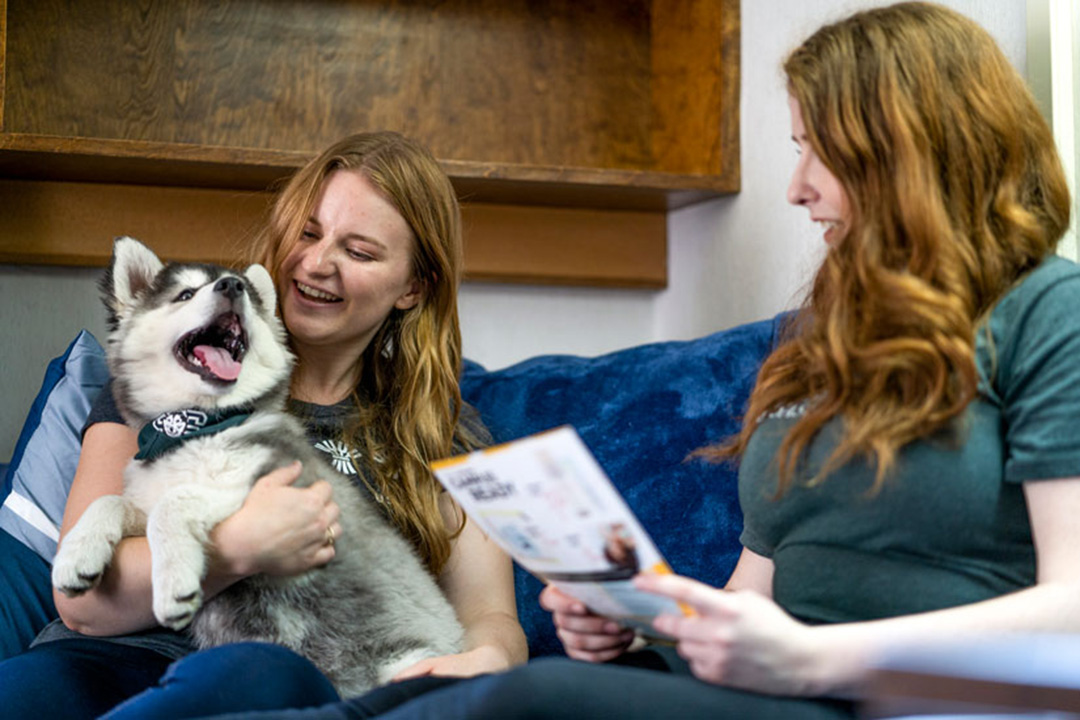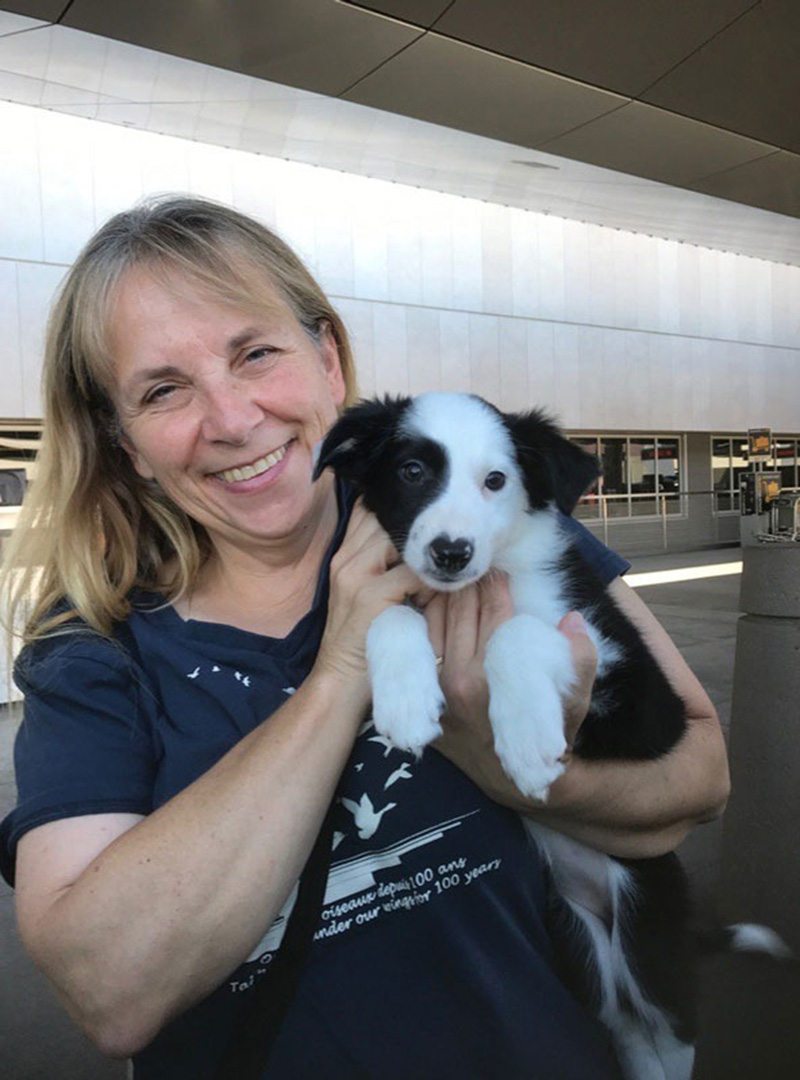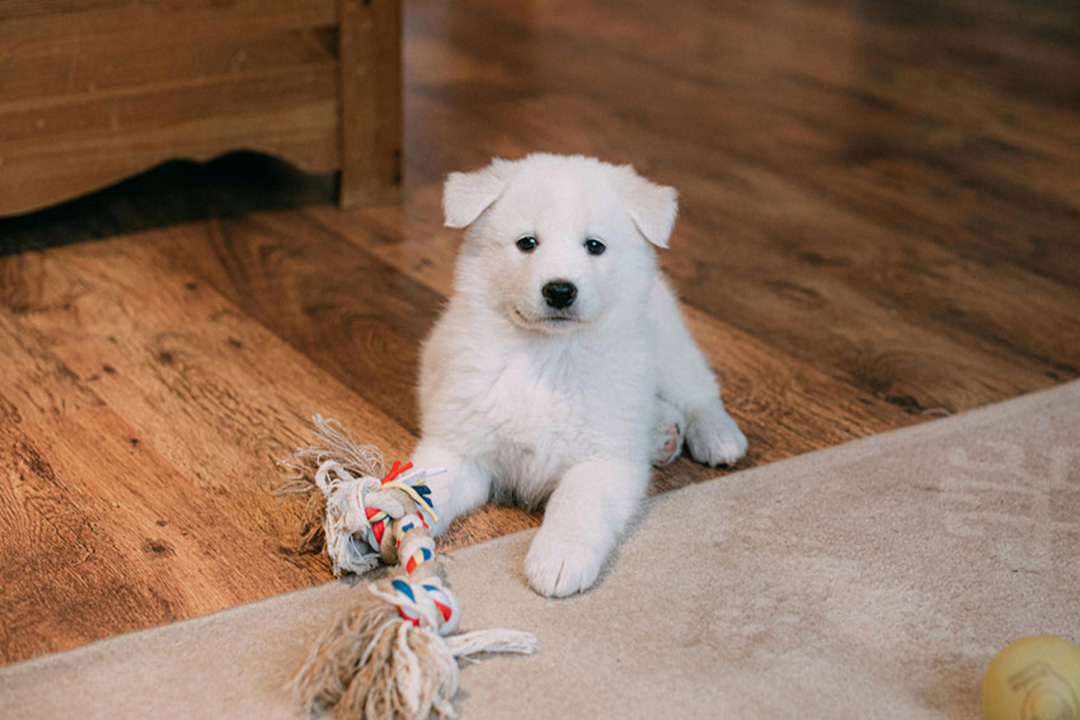
Ask the Alumni Expert: Dr. Karen Machin (MSc’97, PhD’02)
For National Puppy Day, veterinarian Dr. Karen Machin—an expert in animal behaviour and a founder of New Hope Dog Rescue—shares her tips on puppy socialization and how to choose the right dog for you.
By Shannon Boklaschuk
Machin is an associate professor in the Department of Veterinary Biomedical Sciences at the Western College of Veterinary Medicine (WCVM) and an expert in animal behaviour. She is also a researcher, an educator, a lifelong animal owner, and a founder of New Hope Dog Rescue, a registered non-profit and foster-based organization in Saskatoon that has been rescuing and re-homing dogs in need since 2003.
Machin earned her Bachelor of Science and Doctor of Veterinary Medicine (DVM) degrees at the University of Guelph before coming to USask, where she completed her Master of Science and doctoral degrees. She currently teaches animal welfare and behaviour, clinical veterinary behaviour, veterinary communications, chronic pain, nonmammalian pain and analgesia at the WCVM in the DVM program.
Dr. Karen Machin’s puppy tips
1. Choose the right puppy for you
Machin said many factors come into play when choosing a puppy. Often people will adopt puppies because they are cute; and, while there’s nothing inherently wrong with that, people should take their own personal lifestyles into consideration, said Machin. For example, do you want your new puppy to take part in dog sports? If so, then maybe a Basset Hound isn’t the best choice. Are you seeking a dog who will be a “couch potato?” If so, a high-energy dog, such as a Husky or a Border Collie, may not be the right fit. “You want to match it with what your expectations are,” Machin said. “If you are a family that is out hiking and busy in the summertime, that’s fantastic—and then you need a dog that’s going to be able to handle that.” If you are looking to purchase a purebred dog, be sure to research the breeder and find out how they raise their animals and what health checks they do. It’s important to note that many wonderful dogs are available from shelters and dog rescues, such as New Hope Dog Rescue in Saskatoon.
2. Puppy-proof your home
Once you’ve adopted your new puppy, what do you need to do? New puppy parents should ensure their homes are safe spaces for their curious and energetic canine companions. Machin said puppies go through an oral phase and often explore their environments with their mouths. So, since puppies love to chew, it’s important to ensure that household items such as electric cords, phone chargers, and other off-limits pieces of personal property—such as shoes—are out of their reach. “You also need to take care of household plants; many of them can be poisonous,” added Machin. “You need to puppy-proof, looking for potential dangers.”
3. Provide safe items to chew
“It’s normal behaviour for dogs for chew but, at the same time, when they’re teething and their gums are sore, they need an outlet for that,” said Machin. If they are chewing something that they shouldn’t, Machin recommends providing puppies with more appropriate options. That can include purchasing chews at a pet store or creating some homemade items, such as frozen objects that will cool down their gums. “This can be incredibly helpful as those new teeth are coming through the gums, because it’s really uncomfortable,” she said. “A lot of chewing that they do is related to losing their baby teeth and getting their permanent teeth.”
4. Teach your puppy what’s appropriate to chew
Machin emphasized that it’s important not to forcefully take items away from your puppy. “You don’t want to develop an animal that resource-guards,” she said. “If you think about us, as humans, we guard our belongings all the time. It’s normal behaviour to guard belongings. So, when you have to take away something from your dog—or your puppy, in particular—the best thing to do is to trade.” For example, if a puppy is chewing on the leg of a table, a dog owner should redirect the puppy by providing them with an item that they are allowed to chew. If dog owners forcefully take things away from their puppy without trading for an appropriate item, they will convince their puppy that items of value will continue to be taken from them—and that will make the puppy even more unwilling to stop chewing inappropriate things. By giving them something else to chew, however, dog owners can assure their pet that they’re not “the bad guy” who takes things away from them while also teaching them what is appropriate to chew. “You’re kind of solving two things at the same time,” Machin said.

5. Have fun with frozen treats
As we head into the spring and summer months, Machin said puppy owners can provide their pets with large blocks of ice that are filled with fun items, such as kibble, fruits and vegetables, or toys. An ice block can serve multiple purposes: it can be a source of hydration, a source of food, and a way to occupy the puppy when the owner is busy. To encourage puppy interaction with the ice, owners may want to use unsalted broth at first and then transition to water once the puppy understands that it’s fun to play with the ice block, Machin said. Licking and chewing are calming behaviours for puppies so, if they get overstimulated, providing a fun, positive outlet for chewing and licking will help to calm them down. “That teaches them how to deescalate,” she said.
6. Use food to enrich your puppy’s life
Dog owners can utilize their puppy’s feeding time to enrich their pet’s life, since dogs enjoy working for their food. “Use that food to your advantage; your puppy does not have to get food out of a bowl—in fact, I would recommend against that,” said Machin. Instead, puppy owners can use food toys and puzzle bowls, which provide puppies with mental enrichment. Children can also play with their puppy by hiding food for the puppy to find. Machin said these enrichment options don’t have to be expensive. “During the summer, take a handful of kibble and throw it into the yard—now your dog is going to go out and be a dog and search for their food,” she said. “There’s all kinds of ways to enrich the life of your animal, especially early on when they’re developing that brain.”
7. Be aware of your puppy’s weight
Machin encourages owners not to overfeed their puppies as it can lead to obesity, which predisposes them to health conditions and diseases such as early osteoarthritis. “It’s obviously important that people are cognizant of their pet’s weight and try to keep them healthy,” said Machin.
8. Take your puppy for vaccinations
Machin said it’s “incredibly important” for dog owners to ensure their animals are up to date with their vaccinations. It’s an easy and cost-effective way to protect their dogs’ health as well as human health. “We do have high numbers of dogs that do get exposed to both parvovirus and distemper. We have unvaccinated dogs and wild animals, that visit the parks that we like to go to, that may spread diseases,” said Machin. “Distemper, in particular, is most of the time lethal (for dogs), and parvovirus can be lethal as well.”
9. Ensure your puppy is comfortable with confinement
It’s important to ensure your puppy is comfortable with confinement for various reasons. For example, if the puppy needs to stay at veterinary clinic or at a kennel for a prolonged period, then being in a confined area won’t be surprising to them and they will know how to deal with it. Being comfortable with confinement is also helpful when dog owners are house training a puppy, as puppies are unlikely to have an accident in a smaller space—particularly if they are utilizing it periodically to sleep. However, Machin cautions against simply putting a puppy in a room or a crate and then closing the door. Instead, the puppy will need things to keep them occupied, such as food puzzles or other items to lick and chew. Machin trains her own dogs to stay in a crate by feeding them a meal there, so that they will have a positive association with the space. She also advises dog owners to take the confinement training slow if the puppy gets upset—perhaps just close the door for two seconds at a time in the beginning, she said. “You don’t want to stress them.”
10. Find a quiet place for your puppy to sleep
Puppies, just like human babies, need their rest—and it’s important that they have a quiet place to sleep away from the busy activities of the household. “Dogs, including puppies, should be getting 14 to 16 hours of sleep a day—so it is normal if your dog sleeps a lot,” said Machin.
11. Spend time socializing your puppy
Machin said spending time to socialize a puppy is one of the most important things owners should do. “What I like to call it is a ‘vaccination against stress,’ ” she said. “This is where your socialization comes in, where you expose your puppy to things that are in its environment—to people, other dogs, children, various noises, etcetera, so the dog learns to be comfortable around these things. The most important part of this is that it needs to be done in a positive way, with the least amount of fear associated with these introductions as possible. That is imperative, because if the puppy has a really bad experience and is really frightened, that can be very difficult to get over. It’s really important that these early experiences are positive, fear-free, and done slowly.”
12. Don’t punish your puppy
Machin said dog owners should avoid punishing their puppy, as it can create “an unsureness” between the puppy and their owner. Depending on how much punishment is used, it can threaten the animal-human bond and even cause aggression. “The second thing is, is that it doesn’t tell them what to do,” she said. “It tells them what not to do, but what do you want your dog to do? That’s what you have to train.” Machin said positive reinforcement is the most effective way to train a puppy and it will result in the best human-animal relationship. She also suggests enrolling in a puppy class where positive reinforcement and force-free methods are used, and to find an experienced trainer with a good reputation to support the puppy training efforts without the use of aversive training tools.
